Firefly Alpha
Launchers and Propulsion
Firefly Alpha Commercial Launch Vehicle of Firefly Aerospace
Firefly Aerospace Inc. ("Firefly"), headquartered in Austin, TX, is committed to providing economical and convenient access to space for small payloads through the design, manufacture and operation of reliable launch vehicles. The Firefly team addresses the market's need for flexible access to space with a "simplest/soonest" approach to technology selection. Firefly launch vehicles embody the insights of a diverse design team and leverage commercial off–the–shelf (COTS) components, manufactured by suppliers across the United States, to reduce risk, maximize reliability and minimize development time. 1)
Led by CEO Tom Markusic and a team of space industry veterans, Firefly is on track to deliver a US solution for the 1,000 to 4,000 kg payload class to LEO by early 2021 for a starting price of $15M. Firefly is committed to doing its part to restore U.S. leadership in the small to medium launch market, and is establishing international offices and strategic partnerships to effectively serve the global market.
Firefly is developing a family of launch vehicles and in-space services that provide industry-leading affordability, convenience and reliability. Firefly's launch vehicles utilize common technologies, manufacturing infrastructure and launch capabilities, providing LEO launch solutions for up to four metric tons of payload. Combined with Firefly's in-space services, Firefly provides the space industry with access to frequent launches at the lowest cost/kg, enabling ambitious commercial and exploration missions from LEO to the Moon. Headquartered in Cedar Park TX, Firefly has additional presence in Washington, D.C., Dnipro, Ukraine and Tokyo, Japan. Firefly is financed by Noosphere Ventures of Menlo Park, CA (Ref. 6).
Firefly Alpha is designed to address the needs of the burgeoning small–satellite market. At a dedicated mission price of $15M, Alpha combines the highest payload performance with the lowest cost per kilogram to orbit in its vehicle class. Capable of delivering 1 metric ton to Low Earth Orbit (LEO) and 630 kg to the highly desirable 500 km Sun–Synchronous Orbit (SSO), Alpha will provide launch options for both full vehicle and ride share customers.
Alpha will launch twice per month, a launch cadence that will enable customers to fly according to their schedule and to the orbit they desire. Firefly Aerospace Payload User's Guide.
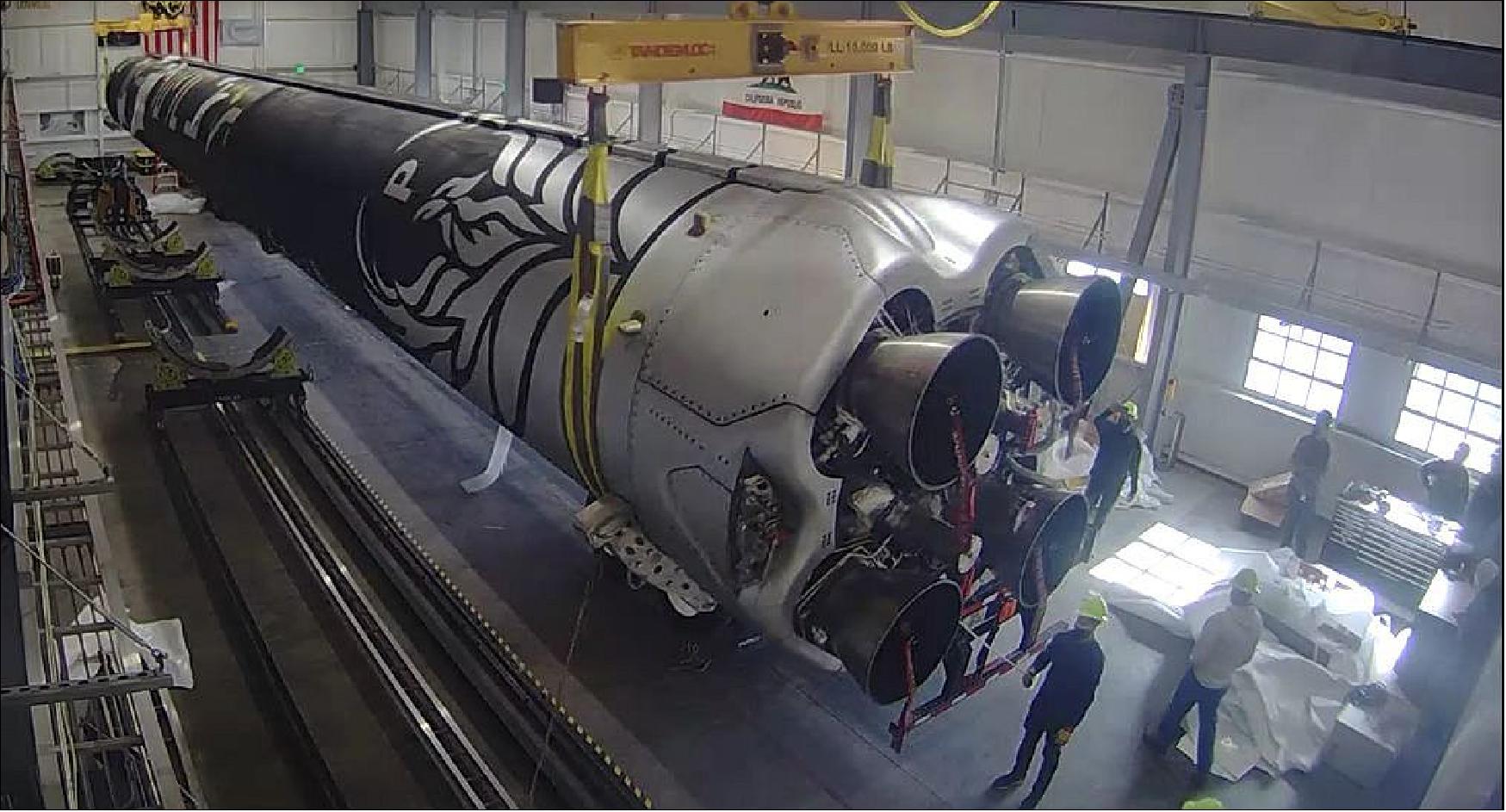
Development Status
• December 30, 2021: Firefly Aerospace is pausing preparations for its next Alpha launch, originally scheduled for early 2022, after the government asked its largest shareholder to divest its stake for national security reasons. 3)
- Noosphere Venture Partners, a fund run by Ukrainian-born investor Max Polyakov, said Dec. 29 that it will retain an investment banking firm to sell its interest in Firefly. That sale comes at the request of the Committee on Foreign Investment in the United States (CFIUS), the company said. Bloomberg was the first to report Noosphere's plans.
- Firefly, in a statement to SpaceNews, said that, because of that request, it is holding off on preparations for its second Alpha launch. "During this process, the government has made a decision to limit our operations at Vandenberg Space Force Base while this issue is being resolved," it stated. "Firefly is actively working with our government partners to mitigate any regulatory issues that may impact launch operations."
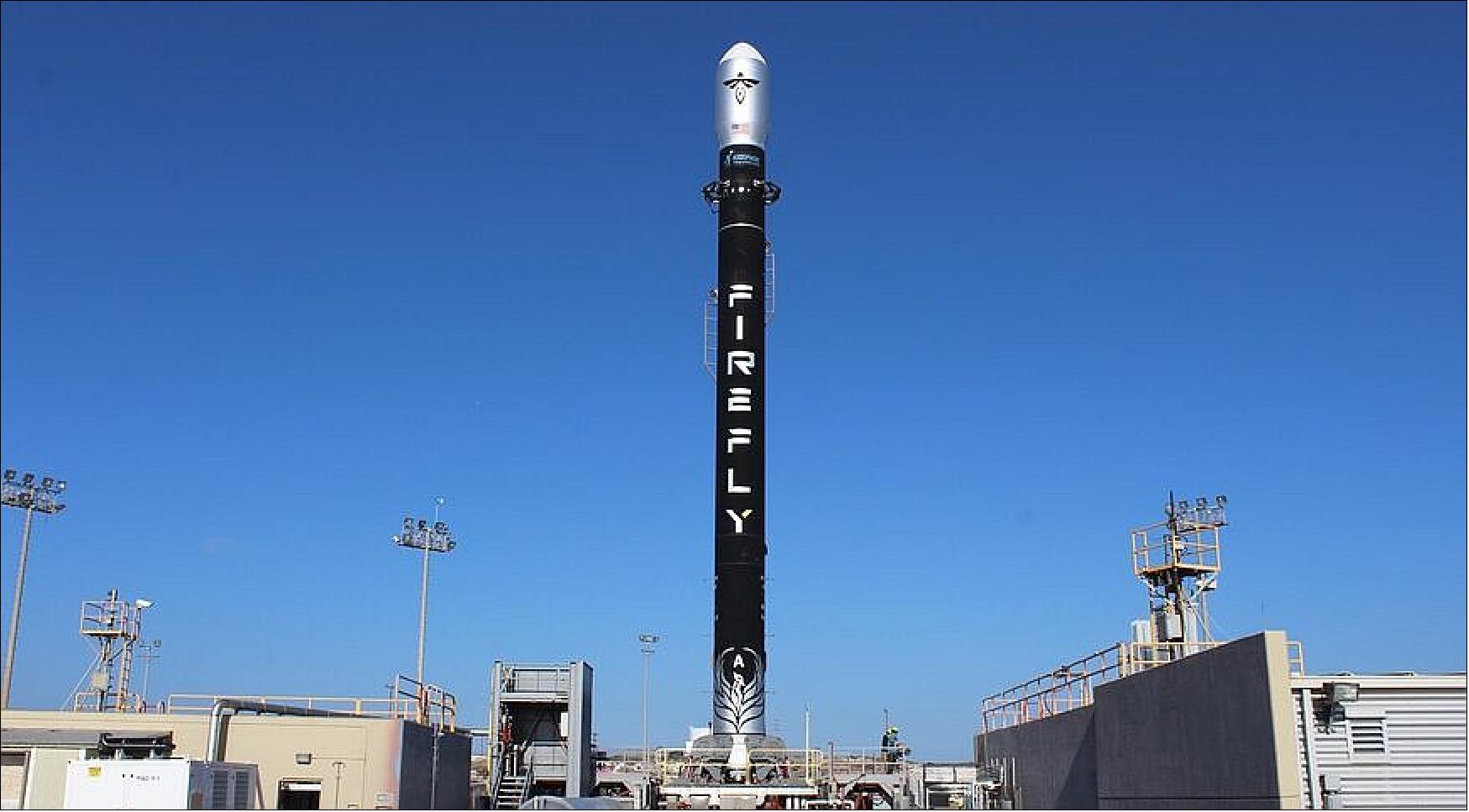
- Space Launch Delta 30, the Space Force unit responsible for launch activities at Vandenberg, did not respond to a request for comment Dec. 29 regarding that pause on Firefly launch preparations.
- Polyakov acquired the assets of the former Firefly Space Systems in 2017 after it filed for bankruptcy. He invested $200 million to resurrect the company and allow it to continue development of its Alpha small launch vehicle, which made its first orbital launch attempt in September. Noosphere said in its statement that it owns an "approximately 50% stake" in Firefly.
- Polyakov's ownership stake had not been a serious issue for Firefly in the past. The company secured access to Space Launch Complex 2W at Vandenberg for its Alpha launch vehicle. It also won NASA contracts, such as an award from the Commercial Lunar Payload Services program for a lunar lander mission scheduled for 2023.
- Firefly, though, had been de-emphasizing Polyakov's role in the company before the CFIUS notice. When the company raised a $75 million Series A round in May, Noosphere sold an additional $100 million of its shares in Firefly, a move it said was to satisfy "overwhelming demand" from investors. Polyakov was also quietly dropped from the board of directors last year, which now includes former U.S. government officials such as Deborah Lee James, former secretary of the Air Force, and Robert Cardillo, former director of the National Geospatial-Intelligence Agency.
- Before the government decision to halt Firefly launch preparations, the company had been gearing up for an Alpha launch as soon as late January. In an interview in November, Jason Mello, president of Firefly Space Transportation Services, the Firefly subsidiary responsible for Alpha launch sales, said the premature engine shutdown that doomed the first launch had a "fairly easy and straightforward" solution. He said the company would conduct up to four more Alpha launches in 2022 if the upcoming launch was a success.
- Firefly did not mention in its statement how long of a delay it projected for its next launch because of the sale of Noosphere's stake. "Our plans for multiple flights in 2022 are continuing with the finalization of Flight 2 testing and preparation for transport, along with the development of Flight 3 and 4 vehicles, which are currently in production," the company stated.
- Firefly is not the first space company to be tripped up by national security concerns regarding foreign ownership.
- Momentus said in November that it was making "significant progress" on implementing a national security agreement with the federal government and was on track to get approvals for launching its first tug in the middle of 2022.
• August 24, 2021: Firefly Aerospace is ready to make its first orbital launch attempt next week as the company balances a transition to operations with plans to develop new rockets and spacecraft. 4)
- Firefly announced Aug. 19 that it had set a Sept. 2 date for the first launch of its Alpha rocket from Vandenberg Space Force Base in California. The announcement came a day after the small launch vehicle performed a successful 15-second static fire test on the pad at Vandenberg.
- In an interview during the 36th Space Symposium on Aug. 24, Tom Markusic, chief executive of Firefly, said the only milestone left before the scheduled launch is finalizing paperwork. "The static-fire test was perfect," he said. "If we had let the rocket go it would have flown. All the data looks great."
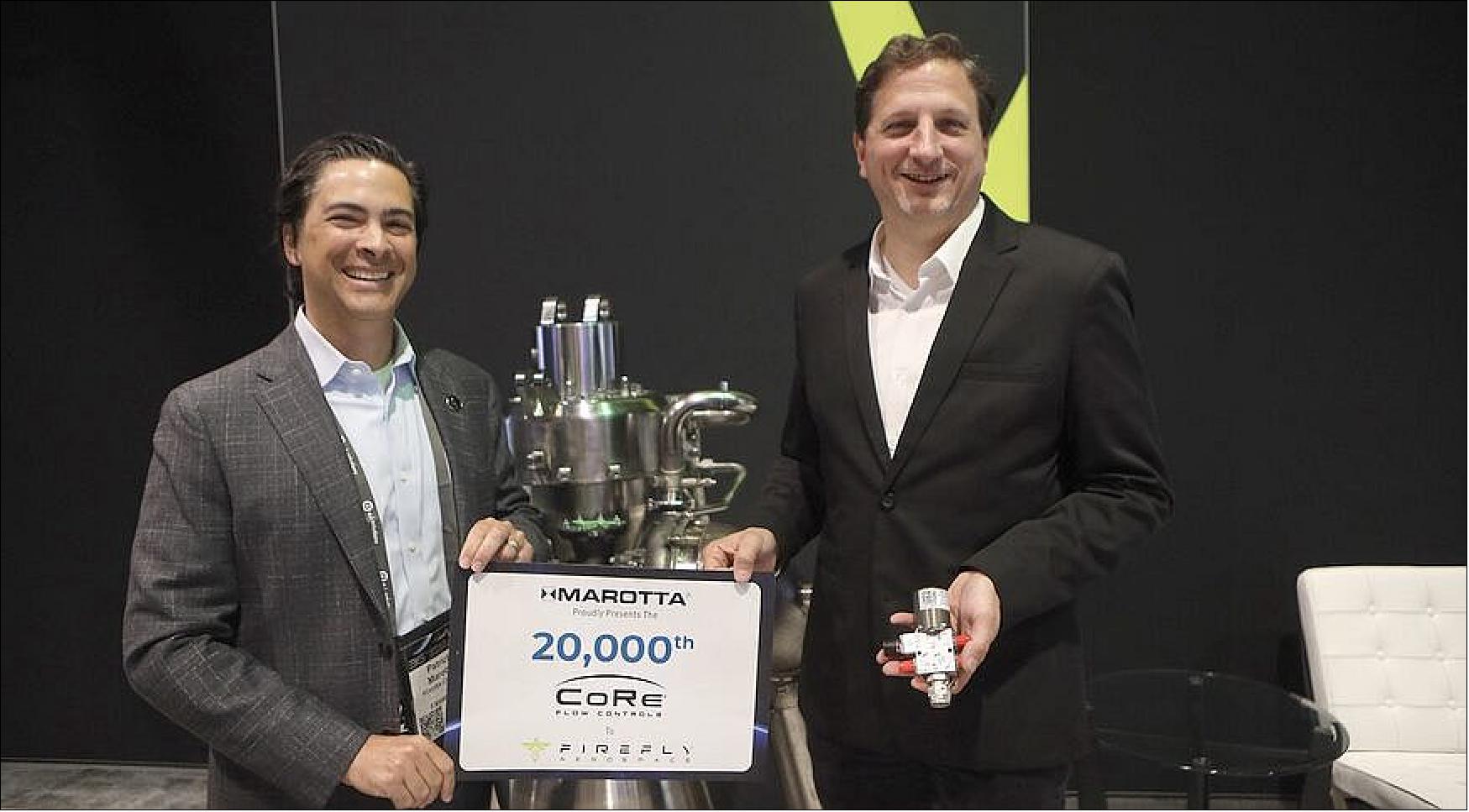
- The company has extensively tested that rocket, including nearly 20 hot-fire tests. "This vehicle has definitely been put through its paces," he said. "We're ready to go."
- The rocket could have been ready sooner but for the delayed delivery of a component needed for its flight termination system. Markusic declined to identify the specific component or its supplier, but said it was one of the few major components that the company did not develop in-house.
- "The vendor could not get the components qualified and delivered on time," he said. "We're a year behind schedule on that flight termination system."
- The inaugural Alpha launch will carry a payload called the Dedicated Research and Education Accelerator Mission (DREAM), a Firefly initiative to provide a free launch for academic and other private payloads. The launch will also test components of an orbital transfer vehicle the company is developing called the Space Utility Vehicle.
- If the first launch is a success, Markusic said a second Alpha would be ready for launch as soon as December carrying a commercial payload. However, he acknowledged that the first launch of a new vehicle carries a higher risk of failure.
- "It's not unusual to have an anomaly on the first flight and then, just depending on the severity of the anomaly, it could be several weeks to several months" to correct the problem, he said. "Alpha is a pretty straightforward rocket design, so whatever problem we might have, we think it is something that can be addressed relatively quickly."
- A successful launch would create a different set of challenges, as Firefly moves from development to operations. "The transition from R&D to production is going to be very hard," Markusic said.
- Firefly announced Aug. 17 it hired a new chief operating officer, Lauren Lyons, who previously worked at SpaceX and Blue Origin. "She is going to focus on establishing the infrastructure and the capability to go to scale production while we still keep and grow that core hardware development capability for new vehicles," he said. "You have to have both."
- Markusic said he will focus more on new vehicle development, including a medium-class launch vehicle called Beta as well as the Space Utility Vehicle and the Blue Ghost lunar lander. He said Firefly recently completed a conceptual design of Beta, which the company plans to develop over the next three years.
- Firefly is also moving into the components business, starting with offering the engines it developed for Alpha to other customers. Markusic said Firefly has a contract to deliver about 50 engines to an unidentified company developing its own launch vehicle.
- That's a departure from the approach most companies have taken to be as vertically integrated as possible. "If you really want to get economies of scale, the more you can make, the better," he said.
- That components business will expand to other items, such as composite-overwrapped pressure vessels. "We have grander aspirations to have a large-scale e-commerce presence," he said. "The dream is to point, click, and have a rocket engine the next day."
• May 4, 2021: Firefly Aerospace, nearing the first launch of its Alpha rocket, announced May 4 it raised $75 million in a Series A round that values the company at more than $1 billion. 5)
- The company said the Series A round was led by DADA Holdings, with participation from Astera Institute, Canon Ball LLC, Reuben Brothers Limited, SMS Capital Investment LLC, Raven One Ventures, The XBTO Ventures and other investors. In addition, Noosphere Ventures, Firefly's largest investor, sold $100 million of its holdings to some of the Series A investors through secondary transactions to satisfy what the company called "overwhelming demand" in the funding round.
- In January, Tom Markusic, chief executive of Firefly, said the company was looking to raise $350 million to fund the ramp-up of its operations over the next five years and development of a larger, medium-class launch vehicle. That remains the goal, he said in a recent interview, but the company decided to split the funding into two separate rounds.

- "The rationale for doing that is that, in general, you don't want to take more money than you need as a startup company, because it involves the dilution if you take too much," he said. "But you do want to take enough so that you have enough runway to get the things you need to get done in the near term."
- A smaller round allows some investors to come in at a "relatively low" valuation, he said. The larger round, which could come after the first Alpha launch, would be at a higher valuation, "minimizing dilution and also benefiting those investors that came in on an earlier round." That larger round, which Firefly expects to be $300 million, could be raised later this year.
- The Series A round, he said, is sufficient to fund the company for the next year even on an "aggressive" development schedule. "I'm just so confident that the accomplishments of the company are going to be so substantial in the next year that it makes sense for us to sort of go for it and not take a lot more than we need right now."
- The group of Series A investors are "people that have a passion for space," he said. "It's always great to have investors that aren't just financial investors, that they actually are excited about the mission and they want to be involved in the mission." One of those investors, Jed McCaleb of Astera Institute, an organization that describes itself as "researching and discovering high leverage technology" to benefit society, will join Firefly's board.
- The company's first Alpha rocket is at Vandenberg Air Force Base in California as the company conducts final tests of both the vehicle and the launch site ahead of its inaugural launch. Markusic said the company was hoping to perform a static-fire test of the rocket in the coming weeks but the "awkward stops and starts" inherent with first-time launch operations made it impossible to offer a more precise date.
- "So, we're just taking a slow and measured approach to it, making sure we do everything carefully," he said. "I'd be disappointed if we don't launch in the next couple months."
- Three more Alpha launches are on the company's manifest for October of 2021 and January and June of 2022. The June 2022 launch will be for the NASA Venture Class Launch Services contract the company won last year.
- The first launch will also test technology for an orbital transfer vehicle called the Space Utility Vehicle, such as its solar electric thruster. In parallel, the company is working on Blue Ghost, its lunar lander. The company won a NASA Commercial Lunar Payload Services award in February for that lander's first mission, delivering a set of payloads to the moon in 2023.
- "The lunar lander is really the first contract that validated our end-to-end space transportation paradigm that we're trying to put forward at Firefly," Markusic said. "Blue Ghost, the lunar lander, has really energized the spacecraft side of the business."
- That's helped grow the company to more than 350 employees. The company is preparing to open a new 50,000-square-foot facility at its Cedar Park, Texas, headquarters to support work on its lunar lander and orbital transfer vehicle projects.
- Firefly continues to pursue a medium-class launch vehicle, called Beta. Markusic said that recent announcements by companies like Relativity Space and Rocket Lab that they would develop medium-class vehicles validated its own plans for a larger vehicle. "I've seen that some other companies are suggesting that they're going to do similar vehicles to Beta, which is smart, because it's clear to us that there's a market there."
- The new funding round will support design work on Beta, leading toward a conceptual design review. Markusic said that will include how to best incorporate reusability into the vehicle, as well as development of larger engines to power the vehicle.
- "The long pole will be the engines," he said. "Propulsion will be the big focus in the next few months, which is great, because I love rocket engines."
• February 12, 2021: Firefly Aerospace, Inc., a leading provider of economical and dependable launch vehicles, spacecraft, and in-space services, today announced a Launch Services Agreement with Exolaunch GmbH, a leading provider of launch services, mission management and separation systems, to integrate and launch multi-satellite clusters aboard Firefly's Alpha launch vehicle beginning in 2022. 6)
- Just weeks away from the maiden launch of its Alpha rocket, Firefly plans to swiftly accelerate the frequency of Alpha flights through collaborative partnerships, including this strategic partnership with Exolaunch, a German small-satellite integrator known for its substantial flight heritage, flight-proven deployment technologies and high reliability.
- Exolaunch has previously launched 140 small satellites for its customers and continues to see increasing demand for its launch and integration services across the global launch and small satellite market.
- Firefly will leverage Exolaunch's payload integration expertise and flight-proven launch hardware: CarboNIX shock-free microsatellite separation systems and EXOpod CubeSat deployers, along with EXObox sequencers and EXOport multi-satellite adapters, to help ensure successful joint missions as part of the Alpha launch manifest through 2022 and beyond.
- "This agreement between Firefly and Exolaunch brings together two complementary partners focused on providing affordable space access to a growing number of government, commercial, scientific and academic missions," said Dr. Tom Markusic, Firefly Aerospace CEO. "Exolaunch is one of the leading payload aggregators and integration providers and will work closely with our Firefly team in filling capacity aboard Alpha launch vehicles and meeting the unprecedented demand for space missions over the years ahead."
- Firefly has completed acceptance testing of its Flight 1 Alpha vehicle, which has been delivered to Firefly's Vandenberg Air Force Base Space Launch Complex 2 (SLC-2) launch site for integration. Following an upcoming static fire, Firefly will prepare for Alpha's maiden launch.
- "Exolaunch and Firefly Aerospace share a common goal of opening space to exciting new levels of exploration and economic opportunities, and we look forward to contributing to the success of the Alpha launch vehicle in its quest to affordably deliver spacecraft into orbit," said Jeanne Medvedeva, VP of Launch Services, Exolaunch. "Discussions with a broad range of government and commercial missions are already well underway, as Exolaunch brings both dedicated and rideshare missions to upcoming launches aboard the Alpha rocket."
- Firefly's Director of International Business Development, Alona Kolisnyk added, "This partnership between Exolaunch and Firefly Aerospace will drive a steady cadence of missions on Alpha, providing unique launch opportunities for Exolaunch and its clients. We look forward to many successful missions together."
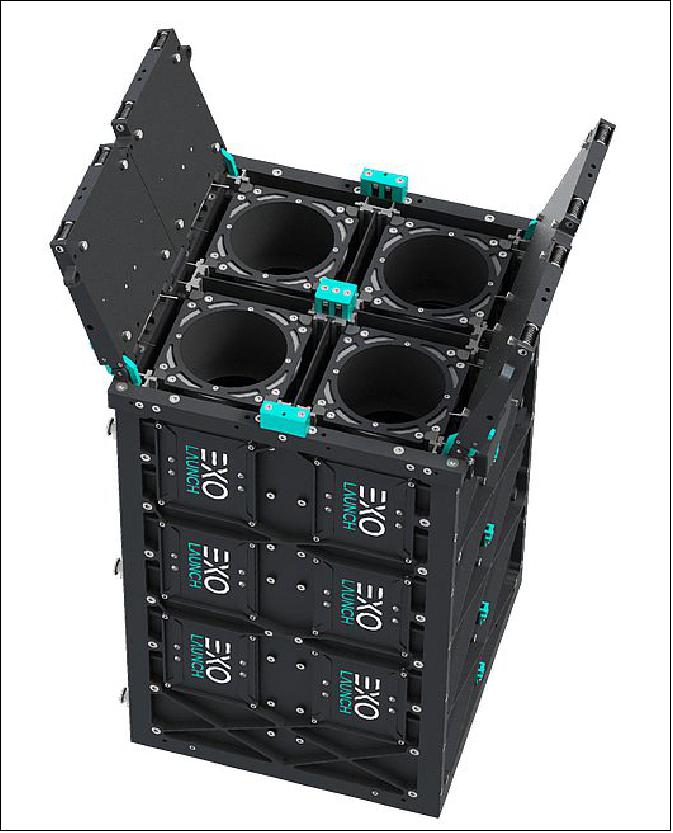
• February 3, 2021: Firefly Aerospace Inc. announced the appointment of Deborah Lee James and Robert Cardillo to its Board of Directors. Firefly's new three-person board, including Firefly CEO, Dr. Tom Markusic, will be led by Ms. James, serving as Chairman of the Board. 7)

• December 11, 2020: Firefly Black, LLC is pleased to announce its selection by the National Aeronautics and Space Administration (NASA) for the launch of Mission Two of the Venture Class Launch Service Demonstration 2 (VCLS Demo 2) contract. Mission Two involves launch of two CubeSat constellations to a 550 km Sun-Synchronous Orbit, separated by a minimum of 10 degrees in plane change. 8)
- "Firefly Black is pleased to have been selected by NASA for this operationally challenging mission. We applaud NASA's commitment to the nation's emerging small launch industrial base and look forward to supporting America's civil space launch needs for many years," said Leslie Kovacs, company President. "The all-private development of our Alpha launch vehicle, and the impending completion of our Space Launch Complex 2 conversion at Vandenberg AFB, are on schedule to support the maiden Firefly Alpha launch in the first quarter of 2021. The men and women of Firefly, and our supply chain partners, are excited by this partnership with NASA."
- Firefly Black will bridge demand between pure small launch capability and that provided by the National Security Space Launch program by providing a family of small-to-medium launchers and in-space transportation services.
- Firefly Black, LLC is the national security and civil space subsidiary of Firefly Aerospace. Firefly Black provides launch services to Department of Defense, intelligence community, and civil space customers seeking small-to-medium launch solutions for up to ten metric tons of payload to low earth orbit (LEO). Utilizing Firefly Aerospace's Alpha and Beta launch vehicles and Space Utility Vehicle, Firefly Black provides America with industry leading capability at the lowest cost/kg in the emerging small launch vehicle class. Headquartered in Washington, DC, Firefly Black also performs Legislative and Executive Branch outreach and advocacy supporting the small satellite and small launch industries.
• October 20, 2020: Firefly Aerospace Inc. today announced the successful acceptance test of the first stage of its Alpha launch vehicle for its inaugural flight later this year, and the execution of new customer agreements. 9)
- Firefly has signed a Launch Services Agreement (LSA) with Spire Global (Spire) for the launch of Lemur spacecraft on the Alpha launch vehicle. The LSA will provide for the launch of Spire spacecraft on multiple Alpha missions over the contract period. Firefly has also executed an LSA with Geometric Space Corporation for the full payload capacity of an Alpha launch vehicle.
- Robert Sproles, Senior Director, Constellation Planning and Operations at Spire said, "The addition of Firefly Alpha to the Spire launch program further diversifies options to populate and replenish our world leading nanosatellite constellation. We are looking forward to flying many successful missions with Firefly."
- Samuel Reid, CEO of Geometric Space Corporation said, "With a 1,000 kg payload capacity to low Earth orbit, Firefly Alpha provides a unique capability in the small launch vehicle market. Geometric Space looks forward to working in conjunction with Firefly and our customers to provide an integrated launch experience on Alpha."
- In addition to the customer agreements, Firefly also provided information on recently achieved Alpha milestones. The Alpha Flight 1 Stage 1 performed a 35 second static fire, including a full suite of thrust vector control maneuvers. Subsequently, a 15 second final trim test was performed, and the stage will now ship to Firefly's launch complex at Vandenberg Air Force Base (VAFB).
- Concurrently, the Alpha Flight 1 payload fairing successfully completed a separation test. The payload fairing separation system was designed and manufactured by Firefly. The system is operationally recyclable, allowing for multiple tests of the flight unit.
- Firefly is also nearing completion of its Launch Control Center, Integration Hangar, and launch pad, including assembly of the Transporter Erector Launcher (TEL) at historic Space Launch Complex 2 West (SLC-2W) at VAFB. Firefly's TEL, built by Firefly's design and fabrication teams in Texas and California, is being integrated and will soon commence ground system activation.
- "The successful first stage acceptance testing is the latest in a series of hardware, facilities and test milestones occurring weekly as we approach the inaugural Alpha launch later this year," said Dr. Tom Markusic, Firefly Aerospace CEO. "Our continued technical successes correspond to increasing confidence and demand from our customers. We welcome Spire and Geometric Space to the Firefly customer family and look forward to delivering their payloads on Alpha, the most capable and economical small launch vehicle on the market."
- The Alpha launch vehicle, which stands 95 feet tall with the capability to deliver 1 metric ton to Low Earth Orbit (LEO) and 630 kilograms to Sun Synchronous Orbit (SSO), is designed to fulfill the needs of the burgeoning small satellite market. Combining the highest payload performance with the lowest cost per kilogram to orbit in its class, Alpha provides launch options for both full vehicle and rideshare missions.
- "Our Alpha launch vehicle fills a major market gap with its ability to deliver four times the current maximum payload of other small satellite launch vehicles. This successful stage 1 test, combined with previous successful stage 2 testing, fully validates the design and manufacture of the Alpha launch vehicle and positions Firefly as the future leader in the one metric ton small launcher class." Markusic added. "I had the good fortune to participate in the development of SpaceX Falcon 1 and Falcon 9, over a decade ago. The current version of Alpha, along with our planned block upgrade to 1,300 kg to LEO, returns long-needed Falcon 1 class mission options to the smallsat market."
• November 19, 2019: Firefly Aerospace (Firefly) announced this past summer the DREAM (Dedicated Research and Education Accelerator Mission)) mission, a global competition to host academic and educational payloads as rideshare participants on the inaugural flight of the Firefly Alpha launch vehicle. Today we are happy to announce the payloads selected to fly on Alpha's maiden flight to support and stimulate STEM on a global basis. There are 26 DREAM payloads representing 7 different countries. 10)
- DREAM payloads will be co-manifested with commercial payloads on the first Alpha launch. Firefly plans to share its DREAM payload stories on its social media starting in late November.
- "We are honored to have received so many outstanding submissions that promote STEM globally," said Firefly CEO Dr. Tom Markusic. "From an all girl's STEM rocket program in Lesotho to leading edge technology demos from distinguished universities, the DREAM payloads embody Firefly's ethos of ‘Making Space for Everyone.'"
• February 22, 2019: Firefly Aerospace on Friday confirmed plans to launch Alpha and Beta rockets from Launch Complex 20 at Cape Canaveral Air Force Station. 11)
- Deepening its ties to the Space Coast, Firefly will manufacture the rockets designed to lift small satellites in a 150,000-square-foot facility to be built at Kennedy Space Center's Exploration Park.
- That will bring more than 200 jobs to a neighborhood including OneWeb Satellites' production facility next door, and Blue Origin's New Glenn rocket factory across the street.
- "Firefly Aerospace is proud to be the newest member of the Florida Space Coast family," Firefly CEO Tom Markusic said in a ceremony at Complex 20, attended by Florida Gov. Ron DeSantis. "Our mass production manufacturing facility in Exploration Park will enable Firefly to produce 24 Alpha vehicles a year, enabling a launch cadence that will support a rapidly expanding global small satellite revolution and the commercialization of cislunar space."
• October 14, 2015: In 2015 NASA's Launch Services Program (LSP) awarded multiple Venture Class Launch Services (VCLS) contracts to provide small satellites (SmallSats) — also called CubeSats, microsatellites or nanosatellites — access to low-Earth orbit. 12)
- The three companies selected to provide these new commercial launch capabilities, and the value of their firm fixed-price contracts, are:
a) Firefly Space Systems Inc. of Cedar Park, Texas, $5.5 million
b) Rocket Lab USA Inc. of Los Angeles, $6.9 million
c) Virgin Galactic LLC of Long Beach, California, $4.7 million
- At present, launch opportunities for small satellites and science missions mostly are limited to rideshare-type arrangements, flying only when space is available on NASA and other launches. The services acquired through these new contract awards will constitute the smallest class of launch services used by NASA.
- LSP supports the agency's CubeSat Launch Initiative (CSLI) by providing launch opportunities for more than 50 CubeSats that are awaiting launch during the next three years. The VCLS contracts will demonstrate a dedicated launch capability for smaller payloads that NASA anticipates it will require on a recurring basis for future science SmallSat and CubeSat missions.
Launch
Firefly Aerospace's first launch of its Alpha rocket ended in failure when the rocket exploded two and a half minutes after liftoff on September 3 at 01:59 UTC (Sept. 2 at 9:59 p.m. EDT). About two and a half minutes after liftoff, the rocket appeared to tumble and then explode. "Alpha experienced an anomaly during first stage ascent that resulted in the loss of the vehicle," Firefly tweeted. 13)
It was the inaugural flight for the two-stage Alpha rocket, which is designed to loft up to 1,000 kg into a low-altitude orbit, or up to 630 kg of payload to a 500 km sun-synchronous polar orbit.
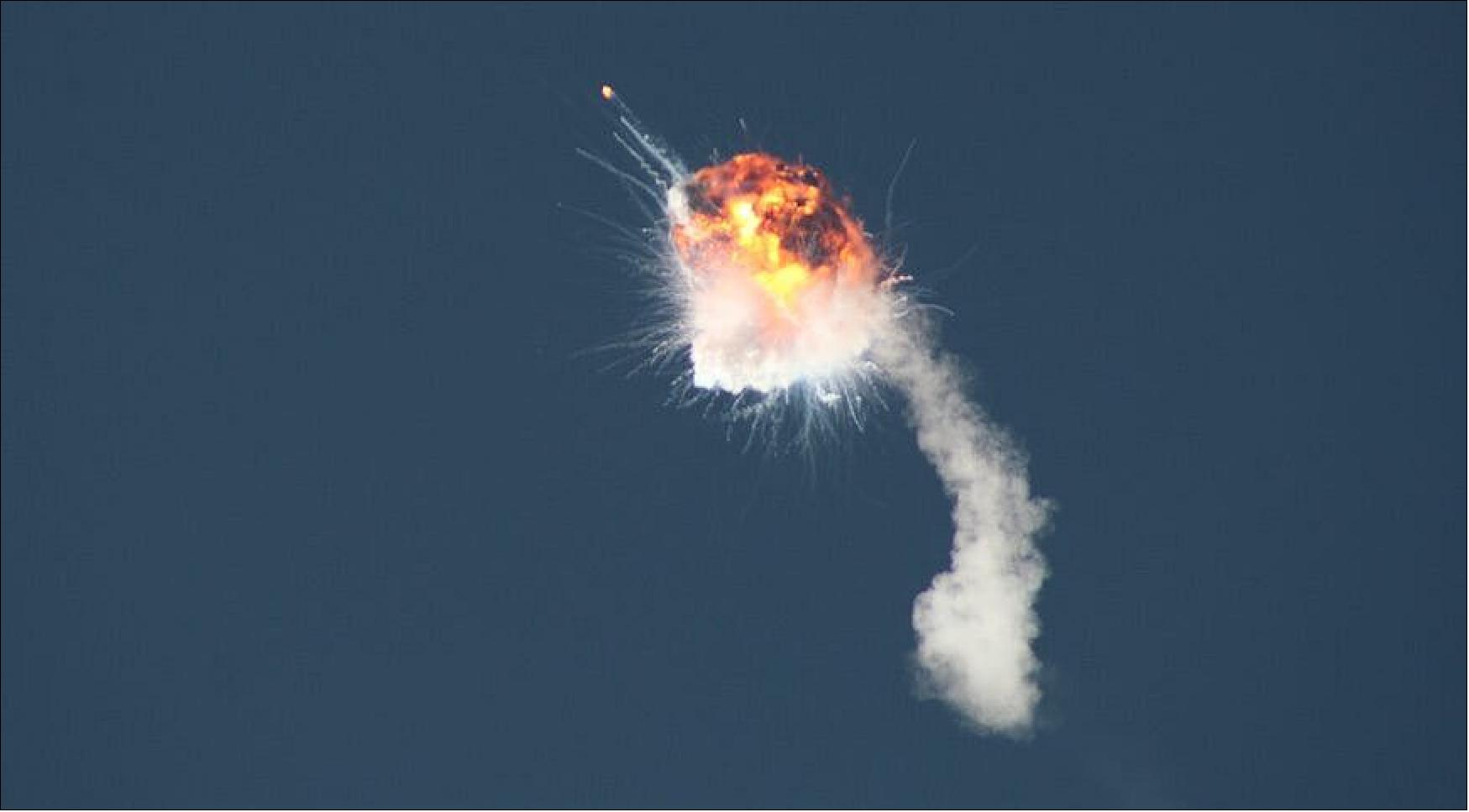
"While it's too early to draw conclusions as to the root cause, we will be diligent in our investigation, in partnership with the FAA and Vandenberg Space Force Base," the company said in a later statement. "While we did not meet all of our mission objectives, we did achieve a number of them: successful first stage ignition, liftoff of the pad, progression to supersonic speed, and we obtained a substantial amount of flight data."
In a separate statement, Space Launch Delta 30 at Vandenberg said it terminated the launch. Both the company and the Space force said there were no injuries, although there are eyewitness accounts of debris from the rocket falling in the town of Orcutt, California, just north of Vandenberg.
The rocket's first stage may have been underperforming. According to a mission overview distributed by Firefly before the launch, the vehicle was supposed to reach the speed of Mach 1 67 seconds after liftoff, followed by maximum dynamic pressure nine seconds later. However, launch controllers did not report that the vehicle was supersonic until 2 minutes and 20 seconds after liftoff, about 10 seconds before the vehicle exploded.
Company executives emphasized before the launch that the flight was primarily a test. "Our really big goal is to get Alpha to space. If we can get to orbit, even better," said Lauren Lyons, chief operating officer of Firefly, during a Sept. 1 tour of the company's launch control center. "Our goals are to collect as much data as we possibly can and take Alpha as far as it can go."
The Alpha was carrying about 92 kilograms of payloads on what it called the Dedicated Research and Educational Accelerator Mission (DREAM). That included several CubeSats, technology demonstrations of a plasma thruster and drag deorbit sail, and "non-technical" payloads like photos and memorabilia.
The mission was designed to fly to the west, rather than to the south as is typical for polar-orbit launches from Vandenberg. While that reduced the payload performance for the mission, it made range safety simpler for an untried rocket.
"If we were flying due south, we'd have a very tight corridor we'd have to go down though," said Tom Markusic, chief executive of Firefly, in a Sept. 1 interview at the pad. "Here, we have a very wide corridor so that, if the vehicle's not tracking quite right, it gives us an opportunity to get back on track without having to terminate the mission."
Payloads of Firefly Maiden Flight
• BSS1 (Benchmark Space Systems), USA, DFAST Demonstrator
• CRESST DREAM COMET, University of Cambridge, UK, a 3U CubeSat to be deployed from a standard CubeSat dispenser to demonstrate a step change propulsion system that has the potential to permit every high school and university to have their own low-cost spacecraft for interplanetary exploration.
• Firefly Capsule 1, USA, Firefly Aerospace, Various nontechnical items from around the world such as photos, artwork, and children'sbooks.
• FossaCon-1, Fossa Systems, An 8P Pocketqube deployer to be used to deploy 8 picosatellites into space and test the worlds first fully free and open source telecommunications constellation
• GENESIS N, AMSAR-EA (Asociación Española de Satélites de Radioaficionado)
• GENESIS L, AMSAT-EA (Asociación Española de Satélites de Radioaficionado)
• QUBIK 1, Libre Space
• QUBIK 2, Libre Space
• FOSSASAT 1b, FOSSA Systems, LoRa communications
• FOSSASAT 2, FOSSA Systems, Photography
• Hiapo, Hawaii Science and Technology Museum, Measure the electric field generated by the solar wind within the thermosphere.
• NPS-CENETIX-Orbital 1, Naval Postgraduate School, Center for Network Innovation and Experimentation (CENETIX). BurstyOrbital Mesh Networking (Dual radio communication board comprised of goTenna Pro X and LoRa radios with combined with Arduino microcontroller)
• Spinnaker3, Purdue University, The FireSail payload is an 18 m2 dragsail, sized to provide deorbit capability for the Firefly upper stage from altitudes of up to 650 km.
• TIS Serenity, Teachers in Space, Inc., Standard Classroom Cubekit Equipment, Collectsflight data during the mission and make it available to the educational community for analysis and comparison to data collected on other flights and vehicles. Typical data collected: Atmospheric pressure, Temperature, Radiation via a matched pair of Geiger counters, one wrapped in experimental radiation protection material, one unwrapped.
Failure Blamed on Premature Engine Shutdown
• Firefly Aerospace said Sept. 5 its first Alpha rocket failed when one of its first-stage engines shut down seconds after liftoff. 14)
- Firefly posted a video of the Sept. 2 launch from Vandenberg Space Force Base in California, which ended when the rocket tumbled out of control about two and a half minutes after liftoff. Space Launch Delta 30, which operates the range at Vandenberg, then destroyed the rocket using its flight termination system.
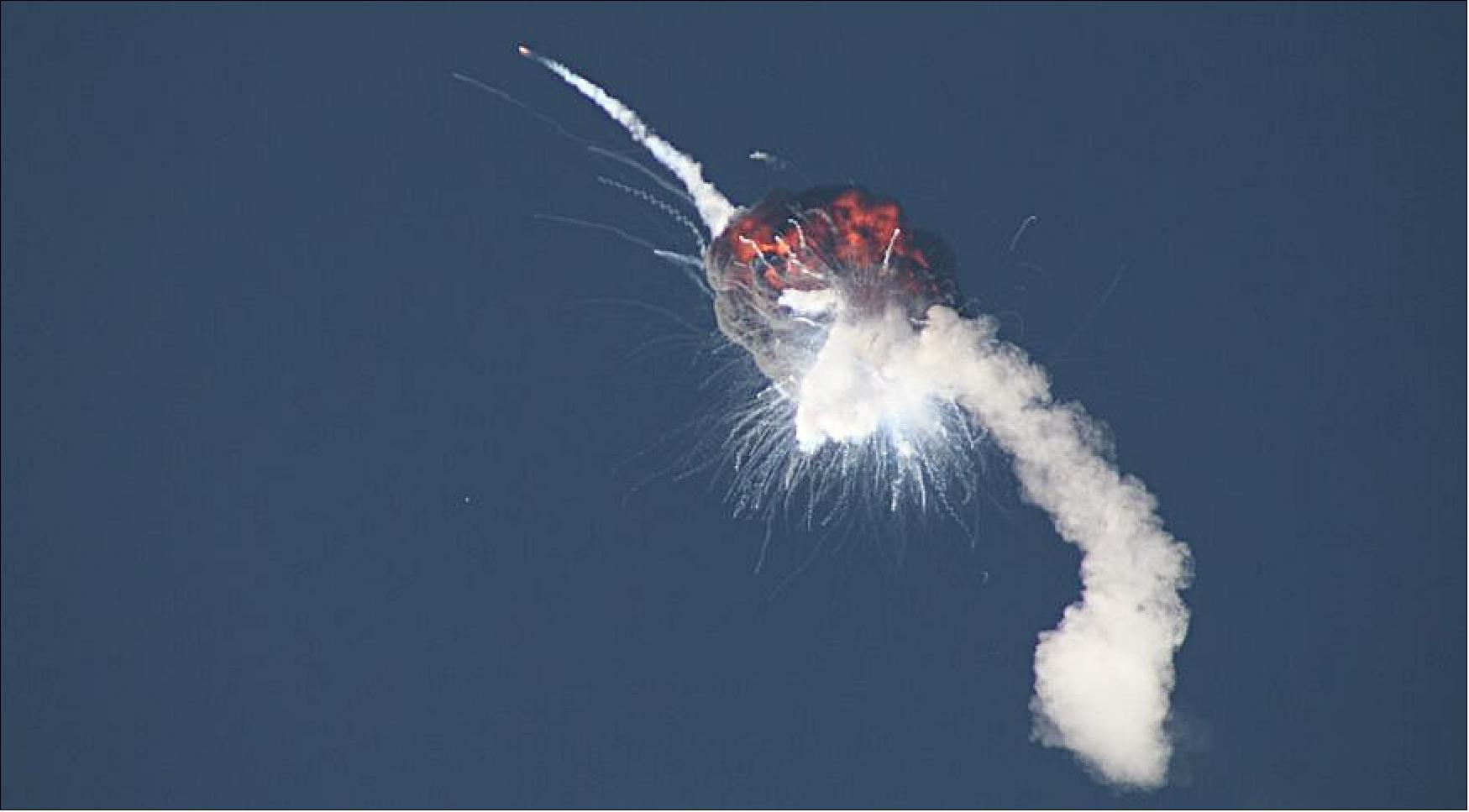
- The rocket continued to ascend using the remaining three engines, but with reduced thrust. That would explain the underperformance apparent in the flight: according to the company's press kit, the vehicle was supposed to reach Mach 1 67 seconds into the flight, but launch controllers did not report that the vehicle was supersonic until 2 minutes and 20 seconds after liftoff.
- Firefly noted that "due to missing the thrust of 1 of 4 engines the climb rate was slow, and the vehicle was challenged to maintain control without the thrust vectoring of engine 2." The vehicle was able to remain stable while going at subsonic speeds, but once it went transonic, "the three engine thrust vector control was insufficient and the vehicle tumbled out of control."
- The video showed that the rocket tumbled for about 10 seconds before the flight termination system destroyed it. The vehicle's payload fairing broke off as the gyrations started but the rocket otherwise remained intact, its remaining engines still firing, until the flight termination system activated.
- The company emphasized before the flight that the launch was primarily a test flight, carrying only a handful of payloads. "It's a flight test, so getting data is success," said Tom Markusic, chief executive of Firefly, in an interview the day before the launch. "The more data we get, the better."
- "Firefly has commenced a thorough anomaly investigation to gain understanding of why engine 2 shutdown early, and uncover any other relevant unexpected events during flight," the company stated. "In collaboration with the FAA and our partners at Space Launch Delta 30, we will return to conduct the second Alpha flight as soon as possible."
References
1) "Firefly Aerospace Company,", URL: https://web.archive.org/web/20220119131537/https://firefly.com/about/
2) Eric Berger, "On eve of first launch, Firefly revamps board of directors, may go public," ars Technica, 3 February 2021, URL: https://arstechnica.com/science/2021/02/on-eve-of-first-launch-firefly-revamps-board-of-directors-may-go-public/
3) Jeff Foust, "Firefly halts launch preparations after federal government seeks divestment of foreign ownership," SpaceNews, 30 December 2021, URL: https://spacenews.com/firefly-halts-launch-preparations-after-federal-government-seeks-divestment-of-foreign-ownership/
4) Jeff Foust, "Firefly Aerospace's Alpha rocket ready for first launch," SpaceNews, 24 August 2021, URL: https://spacenews.com/firefly-aerospaces-alpha-rocket-ready-for-first-launch/
5) Jeff Foust, "Firefly Aerospace raises $75 million Series A round," SpaceNews, 4 May 2021, URL: https://spacenews.com/firefly-aerospace-raises-75-million-series-a-round/
6) "Firefly Aerospace and Exolaunch Announce Launch Services Agreement," Firefly Aerospace, 12 February 2021, URL: https://web.archive.org/web/20221001141929/https://firefly.com/news/firefly-aerospace-and-exolaunch-announce-launch-services-agreement/
7) "Firefly Aerospace Announces New Board of Directors and Corporate Expansion Plans," Firefly Aerospace, 3 February 2021, URL: https://fireflyspace.com/news/firefly-aerospace-announces-new-board-of-directors-and-corporate-expansion-plans/
8) "Firefly Black Awarded NASA Venture Class Launch Services Demonstration 2 Contract," 11 December 2020, URL: https://fireflyspace.com/news/firefly-black-awarded-nasa-venture-class-launch-services-demonstration-2-contract/
9) "Firefly Aerospace Announces New Customer Agreements, Completes Stage 1 Acceptance Testing Ahead of First Alpha Launch," Firefly Aerospace, 20 October 2020, URL: https://fireflyspace.com/news/firefly-aerospace-announces-new-customer-agreements-completes-stage-1-acceptance-testing-ahead-of-first-alpha-launch/
10) "DREAM Payload," Firefly Aerospace, 19 November 2019, URL: https://web.archive.org/web/20221001135852/https://firefly.com/news/firefly-aerospace-announces-dream-payload-participants/
11) "Firefly Aerospace to build, launch rockets on Space Coast," Orlando News, 22 February 2019, URL: https://www.clickorlando.com/news/2019/02/22/firefly-aerospace-to-build-launch-rockets-on-space-coast/
12) Kathryn Hambleton, George H. Diller, "NASA Awards Venture Class Launch Services Contracts for CubeSat Satellites," NASA Press Release 15-209, 14 October 2015, URL:https://www.nasa.gov/press-release/nasa-awards-venture-class-launch-services-contracts-for-cubesat-satellites
13) Jeff Foust, "Firefly Alpha explodes during first launch," SpaceNews, 2 September 2021, URL: https://spacenews.com/firefly-alpha-explodes-during-first-launch/
14) Jeff Foust, "Firefly Alpha failure blamed on premature engine shutdown," SpaceNews, 5 September 2021, URL: https://spacenews.com/firefly-alpha-failure-blamed-on-premature-engine-shutdown/
The information compiled and edited in this article was provided by Herbert J. Kramer from his documentation of: "Observation of the Earth and Its Environment: Survey of Missions and Sensors" (Springer Verlag) as well as many other sources after the publication of the 4th edition in 2002. - Comments and corrections to this article are always welcome for further updates (eoportal@symbios.space).